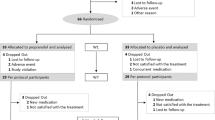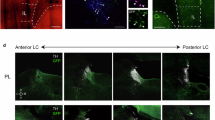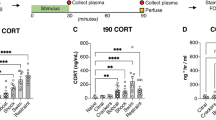Abstract
Early psychological interventions, such as exposure therapy, rely on extinction learning to reduce the development of stress- and trauma-related disorders. However, recent research suggests that extinction often fails to reduce fear when administered soon after trauma. This immediate extinction deficit (IED) may be due to stress-induced dysregulation of neural circuits involved in extinction learning. We have shown that systemic β-adrenoceptor blockade with propranolol rescues the IED, but impairs delayed extinction. Here we sought to determine the neural locus of these effects. Rats underwent auditory fear conditioning and then received either immediate (30 min) or delayed (24 h) extinction training. We used bilateral intracranial infusions of propranolol into either the infralimbic division of the medial prefrontal cortex (mPFC) or the basolateral amygdala (BLA) to examine the effects of β-adrenoceptor blockade on immediate and delayed extinction learning. Interestingly, intra-BLA, but not intra-mPFC, propranolol rescued the IED; animals receiving intra-BLA propranolol prior to immediate extinction showed less spontaneous recovery of fear during extinction retrieval. Importantly, this was not due to impaired consolidation of the conditioning memory. In contrast, neither intra-BLA nor intra-mPFC propranolol affected delayed extinction learning. Overall, these data contribute to a growing literature suggesting dissociable roles for key nodes in the fear extinction circuit depending on the timing of extinction relative to conditioning. These data also suggest that heightened noradrenergic activity in the BLA underlies stress-induced extinction deficits. Propranolol may be a useful adjunct to behavioral therapeutic interventions in recently traumatized individuals who are at risk for developing trauma-related disorders.
Similar content being viewed by others
Log in or create a free account to read this content
Gain free access to this article, as well as selected content from this journal and more on nature.com
or
References
Acca GM, Mathew AS, Jin J, Maren S, Nagaya N (2017). Allopregnanolone induces state-dependent fear via the bed nucleus of the stria terminalis. Horm Behav 89: 137–144.
Arnsten AFT (2009). Stress signalling pathways that impair prefrontal cortex structure and function. Nat Rev Neurosci 10: 410–422.
Arnsten AFT, Raskind MA, Taylor FB, Connor DF (2015). The effects of stress exposure on prefrontal cortex: translating basic research into successful treatments for post-traumatic stress disorder. Neurobiol Stress 1: 89–99.
Bangasser DA, Wiersielis KR, Khantsis S (2016). Sex differences in the locus coeruleus-norepinephrine system and its regulation by stress. Brain Res 1641: 177–188.
Berridge CW, Waterhouse BD (2003). The locus coeruleus-noradrenergic system: modulation of behavioral state and state-dependent cognitive processes. Brain Res Brain Res Rev 42: 33–84.
Bouton ME (2000). A learning theory perspective on lapse, relapse, and the maintenance of behavior change. Health Psychol 19: 57–63.
Bryant RA (2002). Early interventions following psychologicaltrauma. CNS Spectr 7: 650–654.
Bukalo O, Pinard CR, Silverstein S, Brehm C, Hartley ND, Whittle N et al (2015). Prefrontal inputs to the amygdala instruct fear extinction memory formation. Sci Adv 1: 5.
Bush DEA, Caparosa EM, Gekker A, Ledoux J (2010). Beta-adrenergic receptors in the lateral nucleus of the amygdala contribute to the acquisition but not the consolidation of auditory fear conditioning. Front Behav Neurosci 4: 154.
Chang C, Berke JD, Maren S (2010). Single-unit activity in the medial prefrontal cortex during immediate and delayed extinction of fear in rats. PLoS ONE 5: e11971.
Chang C, Maren S (2010). Strain difference in the effect of infralimbic cortex lesions on fear extinction in rats. Behav Neurosci 124: 391–397.
Dębiec J, Bush DEA, LeDoux JE (2011). Noradrenergic enhancement of reconsolidation in the amygdala impairs extinction of conditioned fear in rats—a possible mechanism for the persistence of traumatic memories in PTSD. Depress Anxiety 28: 186–193.
Debiec J, Ledoux JE (2004). Disruption of reconsolidation but not consolidation of auditory fear conditioning by noradrenergic blockade in the amygdala. Neuroscience 129: 267–272.
Deschaux O, Motanis H, Spennato G, Moreau J-L, Garcia R (2011). Re-emergence of extinguished auditory-cued conditioned fear following a sub-conditioning procedure: effects of hippocampal and prefrontal tetanic stimulations. Neurobiol Learn Mem 95: 510–518.
Do-Monte FH, Manzano-Nieves G, Quiñones-Laracuente K, Ramos-Medina L, Quirk GJ (2015). Revisiting the role of infralimbic cortex in fear extinction with optogenetics. J Neurosci 35: 3607–3615.
Fitzgerald PJ, Giustino TF, Seemann JR, Maren S (2015). Noradrenergic blockade stabilizes prefrontal activity and enables fear extinction under stress. Proc Natl Acad Sci USA 112: E3729–37.
Fitzgerald PJ, Whittle N, Flynn SM, Graybeal C, Pinard CR, Gunduz-Cinar O et al (2014). Prefrontal single-unit firing associated with deficient extinction in mice. Neurobiol Learn Mem 113: 69–81.
Fucich EA, Paredes D, Morilak DA (2016). Therapeutic effects of extinction learning as a model of exposure therapy in rats. Neuropsychopharmacology 41: 3092–3102.
Galvez R, Mesches MH, McGaugh JL (1996). Norepinephrine release in the amygdala in response to footshock stimulation. Neurobiol Learn Mem 66: 253–257.
Geracioti TD, Baker DG, Ekhator NN, West SA, Hill KK, Bruce AB et al (2001). CSF norepinephrine concentrations in posttraumatic stress disorder. Am J Psychiatry 158: 1227–1230.
Giustino TF, Fitzgerald PJ, Maren S (2016). Revisiting propranolol and PTSD: memory erasure or extinction enhancement? Neurobiol Learn Mem 130: 26–33.
Giustino TF, Maren S (2015). The role of the medial prefrontal cortex in the conditioning and extinction of fear. Front Behav Neurosci 9: 298.
Goode TD, Maren S (2014). Animal models of fear relapse. ILAR J 55: 246–258.
Hollis F, Sevelinges Y, Grosse J, Zanoletti O, Sandi C (2016). Involvement of CRFR1 in the basolateral amygdala in the immediate fear extinction deficit. eNeuro 3: 5.
Holmes A, Wellman CL (2009). Stress-induced prefrontal reorganization and executive dysfunction in rodents. Neurosci Biobehav Rev 33: 773–783.
Hugues S, Garcia R, Léna I (2007). Time course of extracellular catecholamine and glutamate levels in the rat medial prefrontal cortex during and after extinction of conditioned fear. Synapse 61: 933–937.
Ishizuka Y, Ishida Y, Jin Q, Kato K, Kunitake T, Mitsuyama Y et al (2000). Differential profiles of nitric oxide and norepinephrine releases in the paraventricular nucleus region in response to mild footshock in rats. Brain Res 862: 17–25.
Ji G, Sun H, Fu Y, Li Z, Pais-Vieira M, Galhardo V et al (2010). Cognitive impairment in pain through amygdala-driven prefrontal cortical deactivation. J Neurosci 30: 5451–5464.
Kim SC, Jo YS, Kim IH, Kim H, Choi J-S (2010). Lack of medial prefrontal cortex activation underlies the immediate extinction deficit. J Neurosci 30: 832–837.
Kroes MCW, Tona K-D, den Ouden HEM, Vogel S, van Wingen GA, Fernández G (2016). How administration of the beta-blocker propranolol before extinction can prevent the return of fear. Neuropsychopharmacology 41: 1569–1578.
Lim EP, Dawe GS, Jay TM (2017). Activation of beta- and alpha-2-adrenoceptors in the basolateral amygdala has opposing effects on hippocampal-prefrontal long-term potentiation. Neurobiol Learn Mem 137: 163–170.
Lin C-C, Tung C-S, Lin P-H, Huang C-L, Liu Y-P (2016). Traumatic stress causes distinctive effects on fear circuit catecholamines and the fear extinction profile in a rodent model of posttraumatic stress disorder. Eur Neuropsychopharmacol 26: 1484–1495.
Macpherson K, Whittle N, Camp M, Gunduz-Cinar O, Singewald N, Holmes A (2013). Temporal factors in the extinction of fear in inbred mouse strains differing in extinction efficacy. Biol Mood Anxiety Disord 3: 13.
Maren S (2014). Nature and causes of the immediate extinction deficit: a brief review. Neurobiol Learn Mem 113: 19–24.
Maren S, Chang C (2006). Recent fear is resistant to extinction. Proc Natl Acad Sci USA 103: 18020–18025.
Maren S, Holmes A (2016). Stress and fear extinction. Neuropsychopharmacology 41: 58–79.
Merz CJ, Hamacher-Dang TC, Wolf OT (2016). Immediate extinction promotes the return of fear. Neurobiol Learn Mem 131: 109–116.
Milad MR, Quirk GJ (2012). Fear extinction as a model for translational neuroscience: ten years of progress. Annu Rev Psychol 63: 129–151.
Mueller D, Porter JT, Quirk GJ (2008). Noradrenergic signaling in infralimbic cortex increases cell excitability and strengthens memory for fear extinction. J Neurosci 28: 369–375.
Peters J, Dieppa-Perea LM, Melendez LM, Quirk GJ (2010). Induction of fear extinction with hippocampal-infralimbic BDNF. Science 328: 1288–1290.
Roozendaal B, Okuda S, Van der Zee EA, McGaugh JL (2006). Glucocorticoid enhancement of memory requires arousal-induced noradrenergic activation in the basolateral amygdala. Proc Natl Acad Sci USA 103: 6741–6746.
Sara SJ (2015). Locus Coeruleus in time with the making of memories. Curr Opin Neurobiol 35: 87–94.
Schiff HC, Johansen JP, Hou M, Bush DEA, Smith EK, Klein JE et al (2017). β-Adrenergic receptors regulate the acquisition and consolidation phases of aversive memory formation through distinct, temporally regulated signaling pathways. Neuropsychopharmacology 42: 895–903.
Skelly MJ, Ariwodola OJ, Weiner JL (2017). Fear conditioning selectively disrupts noradrenergic facilitation of GABAergic inhibition in the basolateral amygdala. Neuropharmacology 113: 231–240.
Southwick SM, Bremner JD, Rasmusson A, Morgan CA, Arnsten A, Charney DS (1999). Role of norepinephrine in the pathophysiology and treatment of posttraumatic stress disorder. Biol Psychiatry 46: 1192–1204.
Stafford JM, Maughan DK, Ilioi EC, Lattal KM (2013). Exposure to a fearful context during periods of memory plasticity impairs extinction via hyperactivation of frontal-amygdalar circuits. Learn Mem 20: 156–163.
Stafford JM, Raybuck JD, Ryabinin AE, Lattal KM (2012). Increasing histone acetylation in the hippocampus-infralimbic network enhances fear extinction. Biol Psychiatry 72: 25–33.
Uematsu A, Tan BZ, Johansen JP (2015). Projection specificity in heterogeneous locus coeruleus cell populations: implications for learning and memory. Learn Mem 22: 444–451.
Valentino RJ, Van Bockstaele E (2008). Convergent regulation of locus coeruleus activity as an adaptive response to stress. Eur J Pharmacol 583: 194–203.
Author information
Authors and Affiliations
Corresponding author
Rights and permissions
About this article
Cite this article
Giustino, T., Seemann, J., Acca, G. et al. β-Adrenoceptor Blockade in the Basolateral Amygdala, But Not the Medial Prefrontal Cortex, Rescues the Immediate Extinction Deficit. Neuropsychopharmacol. 42, 2537–2544 (2017). https://doi.org/10.1038/npp.2017.89
Received:
Revised:
Accepted:
Published:
Issue date:
DOI: https://doi.org/10.1038/npp.2017.89
This article is cited by
-
Co-released norepinephrine and galanin act on different timescales to promote stress-induced anxiety-like behavior
Neuropsychopharmacology (2021)
-
Persistent activation of central amygdala CRF neurons helps drive the immediate fear extinction deficit
Nature Communications (2020)
-
Neuromodulation in circuits of aversive emotional learning
Nature Neuroscience (2019)
-
Event boundaries do not cause the immediate extinction deficit after Pavlovian fear conditioning in rats
Scientific Reports (2019)
-
In vivo electrophysiological recordings of the effects of antidepressant drugs
Experimental Brain Research (2019)



